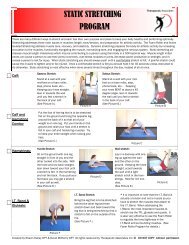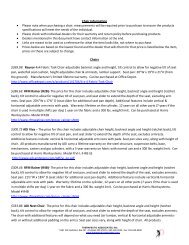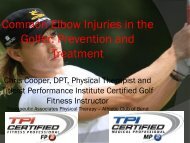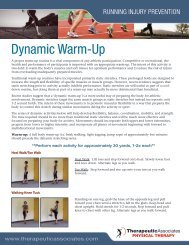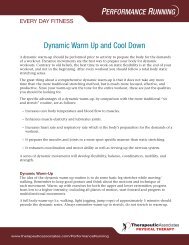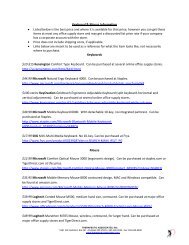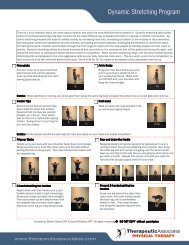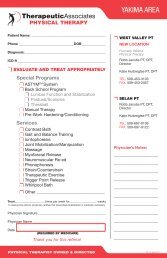[02] NAIOMT C-516 Cervical Spine I - Therapeutic Associates
[02] NAIOMT C-516 Cervical Spine I - Therapeutic Associates
[02] NAIOMT C-516 Cervical Spine I - Therapeutic Associates
Create successful ePaper yourself
Turn your PDF publications into a flip-book with our unique Google optimized e-Paper software.
Course Name: C-<strong>516</strong> <strong>Cervical</strong> <strong>Spine</strong> IFaculty:Clock Hours:All credentialed facultyTwenty-one (21) contact hoursAudience:This course is for licensed physical therapists (copy of physical therapy license required) and third year physicaltherapist interns (school verification required) that are beginning to intermediate learners in the field of orthopedicmanual physical therapy.Pre-requisites:None.Course Description:This course will utilize case-based instruction to illustrate select cervical spine conditions and their detailed, specificbiomechanical and neurophysiological assessment. Participants will identify an all-source evidence-informedapproach to evaluation and management through consideration of normal, abnormal and applied cervical spineanatomy, physiology, biomechanics, and pathology. Coursework will focus on reason-based development ofindividualized examination sequences aimed at patient/client classification into - management of an initial diagnosis,progression to a specific biomechanical and neurophysiological examination, symptom/intervention/rule-basedclassification groupings, or referral to another health-care provider. Participants will identify the concepts of health,functioning, pain behaviors and their manifestations, and their role in total patient/client management. Proceduralinterventions will include education, manual therapy techniques, and individualized neuromuscular rehabilitationprescription, with the goal of restoring normal function and preventing disability. Joint thrust manipulation of themiddle-lower cervical spines will be introduced.Teaching methods/learning experiences:A variety of active learning methods will be incorporated into the case-based presentation of course material,including lecture, laboratory, independent problem assignments, group-based activities, and role-playing.Overall Course Objectives:Upon completion of this three (3) day module, the participant should be expected to:1. Apply an initial patho-anatomical diagnosis to an orthopedic manual physical therapy patient/clientpresenting with cervical spine pathology.2. Assess the patient/client utilizing reason-based, individualized examination sequences and classify thepatient appropriately.3. Evaluate the patient, and develop a detailed, individualized prognosis.4. Outline an all-source evidence-informed management plan including education, manual therapy, andindividually dosed neuromuscular rehabilitation techniques.5. Demonstrate thrust joint manipulation techniques for the middle-lower cervical spine and the cervicothoracicjunction.Specific Course Objectives:Affective Domain:Upon completion of this 3-day module, participants should be expected to:1. Accept that a strong understanding of the basic sciences of normal, abnormal and applied anatomy,physiology, biomechanics, and pathology are essential to the practice of orthopedic manual physicaltherapy.<strong>NAIOMT</strong> C-<strong>516</strong> <strong>Cervical</strong> <strong>Spine</strong> I [v2.0 2-2012] 1
2. Recognize the vital role that all-source evidence-informed clinical reasoning plays in the evaluation andmanagement of orthopedic manual physical therapy patients/clients.3. Realize that all orthopedic manual physical therapy patients/clients present with certain unique signs andsymptoms that require an individualized approach to the evaluation.4. Accept the concept of patho-anatomical diagnosis as the important goal in the evaluation of the orthopedicmanual physical therapy patient/client.5. Accept the importance of Selective Tissue Tension Testing (STTT) to the evaluation and management ofthe orthopedic manual physical therapy patient/client.6. Identify patients who are more appropriately classified using other criteria (Clinical Prediction Rules,Symptom/Intervention based systems).7. Internalize the importance of prognosis as a central factor in the evaluation and management of orthopedicmanual physical therapy patients/clients.8. Display the judgment required to make decisions that take into account, and are in the best interests of, theoverall health and function of the individual.9. Recognize the importance of all-source evidence-informed practice and balance all sources (clinicalexperience, literature, and patient preference) in search of best practices.Cognitive Domain:Upon completion of this 3-day module, participants should be expected to:1. Describe and discuss the current understanding of the normal, abnormal and applied anatomy, physiology,and biomechanics of the cervical spine and temporo-mandibular joint.2. Identify condition (illness) scripts for specific cervical spine and temporo-mandibular joint presentations:a. Systemic disease (cardiovascular, pulmonary, neurological, gastro-intestinal, endocrine, vascular,gynecological, musculoskeletal, integumentary, cancers)b. Fracture/Dislocationc. Arthritis (degenerative/systemic/traumatic)d. Spondylolisthesis (congenital/acquired)e. Disc pathologyf. Radiculopathyg. Stenosis (central/lateral canal)h. Segmental dysfunction (hypomobility, hypermobility, instability)i. Contractile tissue lesionsj. Non-Contractile tissue lesions3. Recognize common orthopedic conditions based on patient age, gender and pain chart information andapply an initial patho-anatomical hypothesis.4. Question the initial hypothesis through targeted subjective questioning.5. Recognize red and yellow flag presentations and discuss the decisions that need to be made about themanagement of these patients.6. Recognize the unique ‘cervical scanning examination’ (the scan), and differentiate the relative worth of itspotential components as applied to cervical spine presentations:a. Observationb. Range of motion (functional, active, passive, combined, overpressure)c. Resisted testingd. Compression and distractione. Dural testingf. Neurological [CNS/PNS – Tests of motor and sensory function]g. Vascularh. Stability<strong>NAIOMT</strong> C-<strong>516</strong> <strong>Cervical</strong> <strong>Spine</strong> I [v2.0 2-2012] 2
i. Palpation7. Recognize the unique specific biomechanical and neurophysiological examination and differentiate therelative worth of its components as applied to the cervical spine:a. Passive Physiological Intervertebral Movements (PPIVM)b. Passive Accessory Vertebral Movements (PAVM)c. Tests of pain provocation (bone, nerve, ligament, soft tissue)d. Joint stability testing8. Identify all-source evidence-informed tests and measures that are relevant to the diagnosis.9. Sequence all-source evidence-informed, reasoned, and individualized examinations specific to cervicalspine condition (illness) scripts.10. Modify individual examination sequences to take into consideration the varying levels of severity andirritability in patient/client presentation.11. Apply a patho-anatomical diagnosis to various patient/client presentations.12. Outline a detailed and individual prognosis for select patient/client presentations.13. Discuss specific indications and contraindications for orthopedic manual physical therapy intervention.14. Utilize case examples to discuss specific, all-source evidence-informed, individualized management plans,taking into account the overall health and function of the individual.15. Discuss relevant clinical prediction rules (diagnostic and prognostic) applicable to the cervical spine.16. Discuss various symptom and intervention-based classification systems applicable to the cervical spine.Psychomotor DomainUpon completion of this 3-day module, participants should be expected to:1. Demonstrate a cervical scan examination:a. Observationb. Range of motion (functional, active, passive, combined, overpressure)c. Resisted testingd. Compression and distractione. Dural testingf. Neurological [CNS/PNS – Tests of motor and sensory function]g. Stabilityh. Palpationi. Vascular2. Demonstrate a specific biomechanical and neurophysiological examination to the upper, middle and lowercervical spine.a. Passive Physiological Intervertebral Movements (PPIVM)b. Passive Accessory Vertebral Movements (PAVM)c. Tests of pain provocation (bone, nerve, ligament, soft tissue)d. Joint stability testinge. Screening of the cervical arterial system3. Demonstrate an appropriate physical therapy examination sequence for the temporo-mandibular joint.4. Demonstrate a modified examination sequence to take into consideration the varying levels of severity andirritability in patient/client presentation.5. Demonstrate the ability to provide education to a patient/client, including prognosis, activity modification,and postural adaptation.6. Demonstrate Orthopedic manual physical therapy intervention techniques:a. Manual therapy techniquesi. General cervical spine manual traction [Upper/middle-lower]ii. General cervical spine mobilization [Middle/lower]<strong>NAIOMT</strong> C-<strong>516</strong> <strong>Cervical</strong> <strong>Spine</strong> I [v2.0 2-2012] 3
iii. Cervicothoracic junction thrust joint manipulationiv. Soft-tissue techniquesb. Rehabilitation techniquesi. Neuromuscular rehabilitation of the cervical spineii. Strength, mobility, and endurance trainingc. Stabilization strategies (including external tape, body mechanics training)d. Neurodynamic interventione. Neural de-sensitizing intervention7. Demonstrate modified variations of the above interventions to take into consideration the varying levels ofpatient/client severity, irritability, and patient/client/therapist body type.* Please note that specific course content will vary according to faculty assessment of the specific skill levelsand needs of the course participants, as well as to remain in full compliance with individual state physicaltherapy practice acts.<strong>NAIOMT</strong> C-<strong>516</strong> <strong>Cervical</strong> <strong>Spine</strong> I [v2.0 2-2012] 4


![[02] NAIOMT C-516 Cervical Spine I - Therapeutic Associates](https://img.yumpu.com/43449457/1/500x640/02-naiomt-c-516-cervical-spine-i-therapeutic-associates.jpg)

